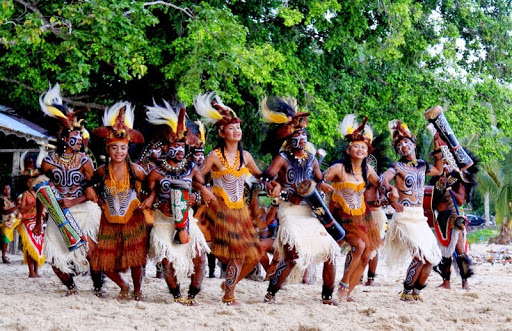papuaaround.com – Sajojo dance is a traditional Papuan dance.
Sajojo dance is a type of social dance that can be danced by anyone of all ages and genders.
This dance is often performed at various traditional and entertainment events and outside Papua this dance is often used for entertainment or gymnastics.
History of Sajojo Dance
This dance is known throughout Indonesia, but the origin of the dance is uncertain. Some sources say the dance existed around the 1990s.
Sajojo dance is famous outside Papua for its agile movements and cheerful dances.
The name of this dance is taken from the name of the song that accompanies it, namely Song Sajojo.
The song Sajojo is a Papuan song about a girl who is idolized and loved in her hometown.
The lyrics of the song don’t describe the sajojo dance, but the cheerful song for the dance matches the dance moves.
Sajojo Dance Movement
The Sajojo dance movement focuses on footwork and also jumping.
Move your feet forward, backward, right, and left. Sajojo dance has a firm movement.
The movements of the Sajojo Dance are as follows:
- The first position, from the bottom half standing and half sitting.
- When the song is played, the movement stands and then jumps forward and backward. The hands are opened forward when jumping forward, and when jumping back the hands are placed down.
- The movement is done several times until the lyrics of the song Sajojo are sung. Jump to the right, then jump back to the starting position.
- When you are in the starting position, clap your hands twice.
- Walk forward and backward four times accompanied by moving the hands to the right and left.
- Do the above movement for several times. After that look at the circle then stomping feet while turning around the circle.
Sajojo Dance Dancer Costume
1. Head cover
The dancers of the Sajojo Dance use a head covering whose shape contains elements of nature. The head cover is made of fine wood, bird feathers, fibers, or sago leaves which are shaped in a circle according to the size of the dancer’s head.
2. Tassel skirt
Tassel skirts are the hallmark of Sajojo dancers. Skirts are worn from the waist to the knees. The tassel skirt is made of sago palm leaves, dried sago leaves, or palm fiber which symbolizes the closeness of the local community to nature.
3. Papuan painting
In the performance of the Sajojo Dance, the dancers will be shirtless.
Even so, they will not leave the body exposed, but the body is painted with typical Papuan paintings in the form of flora and fauna motifs. Paintings are also affixed to the faces, hands and feet of the dancers.
The same way is also done for the female dancers.
Only with the times, female dancers began to use cloth or clothes to cover the chest. So, the only parts that are painted are the face, hands, and feet.
4. Weapons
The weapon used as a complement to the costume is a spear or bow.
5. Necklace
Necklaces are important accessories for dancers. Sajojo dancer necklaces are made of stone, shells, bones, animal teeth or wood.
6. Bracelet
The bracelets worn by the dancers of the Sajojo dancers are sago palm bracelets made of palm fiber, dried sago leaves, thatch, or rope.
Accompanying Songs and Musical Instruments
The song used to accompany the dance is the Sajojo Song which is famous throughout Indonesia.
Dances can be danced without musical accompaniment or with musical accompaniment.
Accompanying musical instruments are commonly used such as tifa, guitar, keyboard, violin, as well as singing from a singer.

